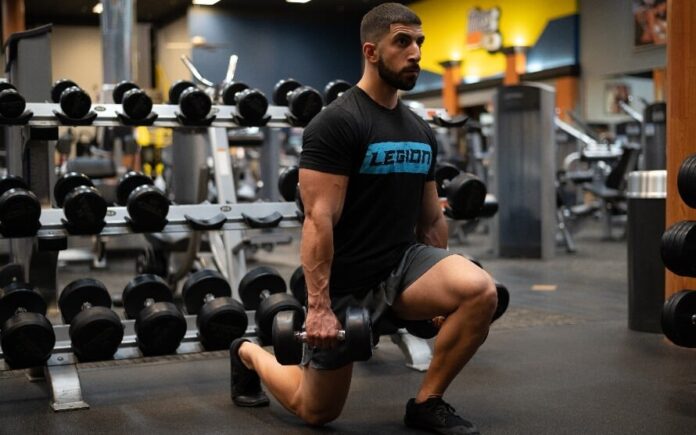PHUL stands for “power hypertrophy upper lower” and is a 4-day workout routine designed to help you gain strength and muscle fast.
Unlike most strength training programs, which focus solely on either strength or size, PHUL combines heavy, low-rep compound weightlifting with higher-rep hypertrophy training to give you the best of both worlds.
In this guide, you’ll learn exactly how the PHUL workout works, what the full routine looks like, and how to adapt it to fit your schedule and goals.
Want to know exactly how you should train to reach your fitness goals? Take our free 60-second training quiz and find out now.
Key Takeaways
- PHUL stands for “power hypertrophy upper lower.” It’s a 4-day workout split designed to build strength and muscle fast.
- On the PHUL workout program, you train each major muscle group twice per week, which research shows is beneficial for size and strength gain.
- Each week includes two workouts focused on strength and two on hypertrophy, giving you the best of both worlds.
- The program emphasizes compound exercises like the squat, deadlift, bench press, and overhead press. These exercises should always be in the program, but you can be more flexible with the “accessory” exercises.
- To accelerate your progress on the PHUL workout program, use a high-quality protein powder to hit your daily protein target, creatine to boost recovery and growth, and a pre-workout to enhance energy, focus, and performance.
- If you want to train more or less often, you can adapt the PHUL workout routine to a 3- or 5-day schedule without sacrificing results.
What Is the PHUL Workout?
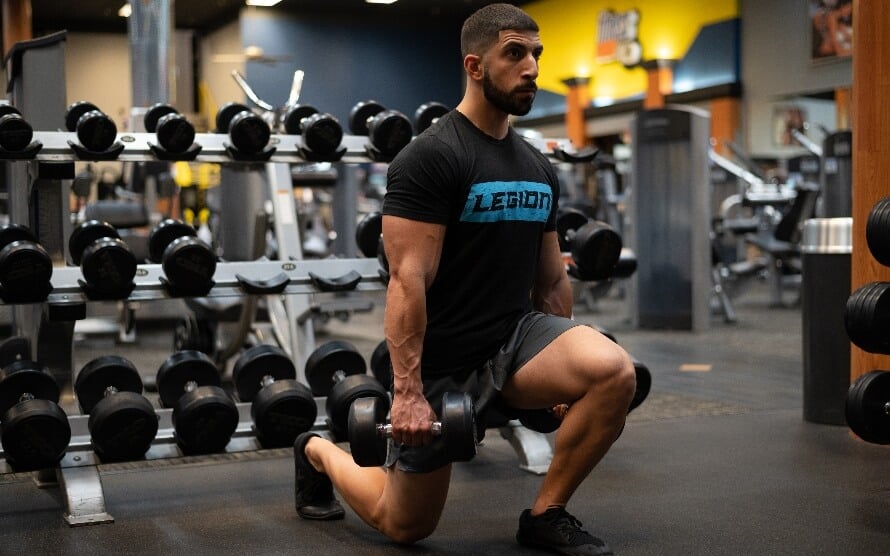
PHUL stands for “power hypertrophy upper lower,” and it refers to a training routine designed to help you gain strength and muscle quickly. You do four workouts per week on PHUL: two upper-body and two lower-body workouts.
Two of these workouts (one upper-body and one lower-body workout) are geared toward gaining strength (power), while the others focus on building muscle (hypertrophy).
PHUL Workout Schedule
Here’s how a week of training on the PHUL workout plan typically looks:
- Day 1: Upper-Body Power
- Day 2: Lower-Body Power
- Day 3: Rest
- Day 4: Upper-Body Hypertrophy
- Day 5: Lower-Body Hypertrophy
- Day 6: Rest
- Day 7: Rest
PHUL Workout Principles
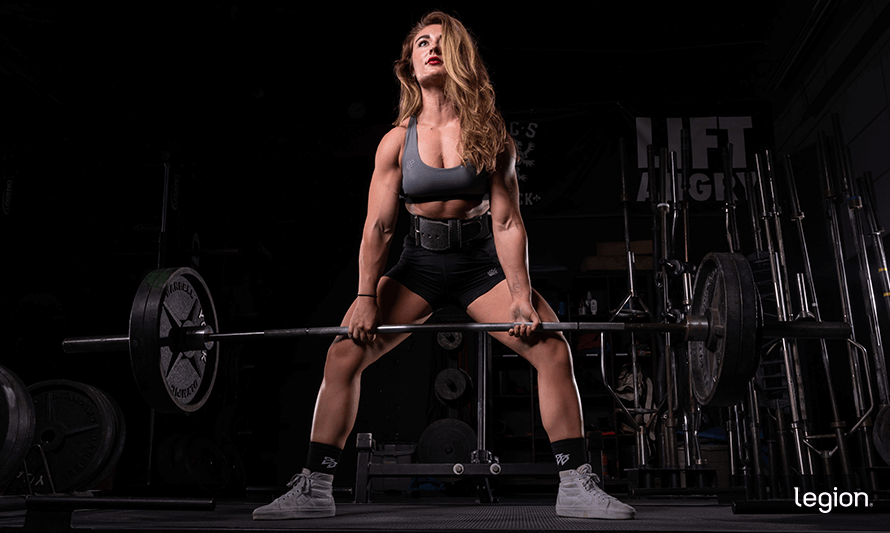
The PHUL workout program is built on four foundational principles: training frequency, compound exercises, power, and hypertrophy. Each plays a key role in helping you build muscle and strength efficiently.
Frequency
You train each muscle group twice per week on the PHUL workout split. Research shows this typically helps you gain muscle and strength faster than when you train less often.
The routine also gives each muscle group at least two days to recover while you work on others. This minimizes your risk of suffering repetitive strain injuries and ensures you can give maximal effort in each workout, which is important for maximizing your progress.
Compound Exercises
PHUL workouts center around compound exercises like squats, deadlifts, and presses. These movements train multiple muscle groups at once, allowing you to lift heavier weights and better apply progressive overload—the primary driver of muscle and strength gains.
You also do isolation exercises (exercises that train one muscle group at a time) to target muscles that compound exercises train less effectively and to ensure you’re doing enough volume (sets) to maximize growth without wearing yourself out.
Power
Two of your weekly PHUL workouts focus on developing power (or more accurately, maximal strength).
In these workouts, you’ll lift heavier weights in lower rep ranges to improve your one-rep max strength. This is important because getting stronger is vital for maximising muscle gain.
Hypertrophy
In the remaining two workouts, you’ll focus on hypertrophy (building muscle).
This involves doing more isolation exercises and lifting slightly lighter weights in higher rep ranges.
The 4-Day PHUL Workout Routine
Below is the original 4-day PHUL workout split, including sets, reps, and rest times for each exercise.
PHUL Workout 1: Upper Power
PHUL Workout 2: Lower Power
PHUL Workout 3: Upper Hypertrophy
PHUL Workout 4: Lower Hypertrophy
- Front Squat: 3-to-4 sets | 8-to-12 reps | 2-to-3 min rest
- Lunge: 3-to-4 sets | 8-to-12 reps | 2-to-3 min rest
- Leg Extension: 3-to-4 sets | 10-to-15 reps | 2-to-3 min rest
- Lying Leg Curl: 3-to-4 sets | 10-to-15 reps | 2-to-3 min rest
- Dumbbell Side Lateral Raise: 3-to-4 sets | 8-to-12 reps | 2-to-3 min rest
- Seated Calf Raise: 3-to-4 sets | 8-to-12 reps | 2-to-3 min rest
- Leg Press Calf Raise: 3-to-4 sets | 8-to-12 reps | 2-to-3 min rest
Notes on the PHUL Workout
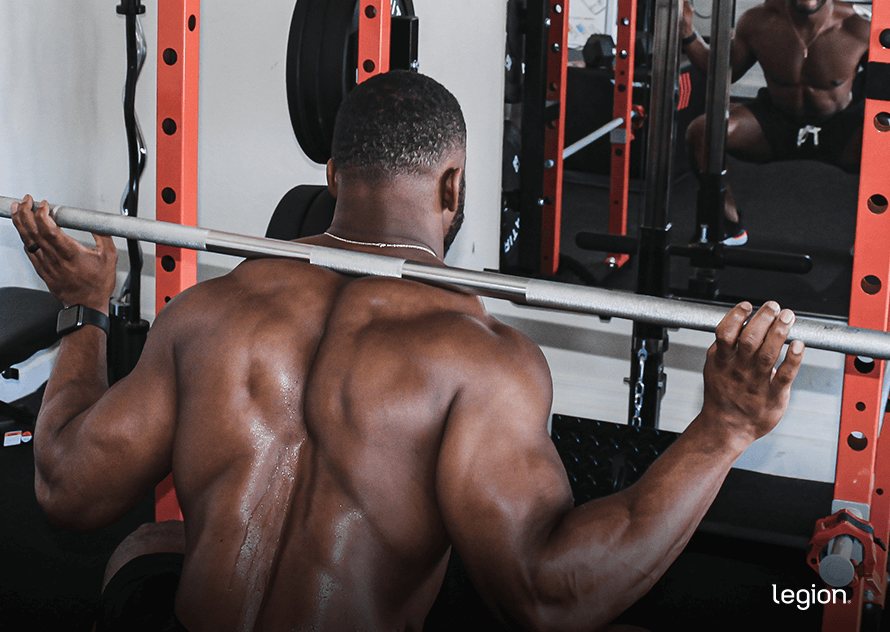
Now that you understand the core principles behind the PHUL routine and what the workouts look like, here are some key notes to help you get the best results from the program.
Sets and Reps
Each exercise includes a set range and a rep range—for example, 3-to-4 sets of 3-to-5 reps. Start with the lowest number of sets when you begin the program, then gradually add sets as you gain strength.
Use the rep range to help you choose appropriate weights. Pick a weight that lets you train close to failure while staying within the target rep range on all your sets. When you can hit the top of the range on every set, increase the weight in the following week’s workout by 5-to-10 pounds.
For example, if your PHUL workout calls for 4 sets of 3-to-5 reps of the bench press, and you do 5 reps in all 4 sets, add 10 pounds when you perform the bench press the following week.
Failure
Training to failure means reaching the point where you can’t complete another rep with good form despite giving maximum effort. On the PHUL workout routine, avoid reaching failure on most sets—leave at least one rep in the tank at the end of each set.
To gauge how close you are to this point, ask yourself at the end of each set: “If I had to, how many more reps could I have done with good form?”
If the answer is more than one or two, increase the weight or reps on your next set.
Exercise Selection
The squat, deadlift, bench press, and overhead press form the foundation of the PHUL program. Don’t swap them out unless an injury or lack of equipment prevents you from doing them.
You can replace accessory or isolation exercises if needed—just make sure your substitutions target the same muscles and serve a similar purpose as the original (you can find some solid suggestions below).
Ab Training
Train your abs at the end of your workouts or on rest days—whichever fits your schedule best.
Just bear in mind that PHUL workouts contain a lot of compound exercises that indirectly train your abs, especially the squat, deadlift, and overhead press, so direct ab work isn’t always necessary. But if you want to include it, feel free to do so.
PHUL Workout Exercise Substitutions
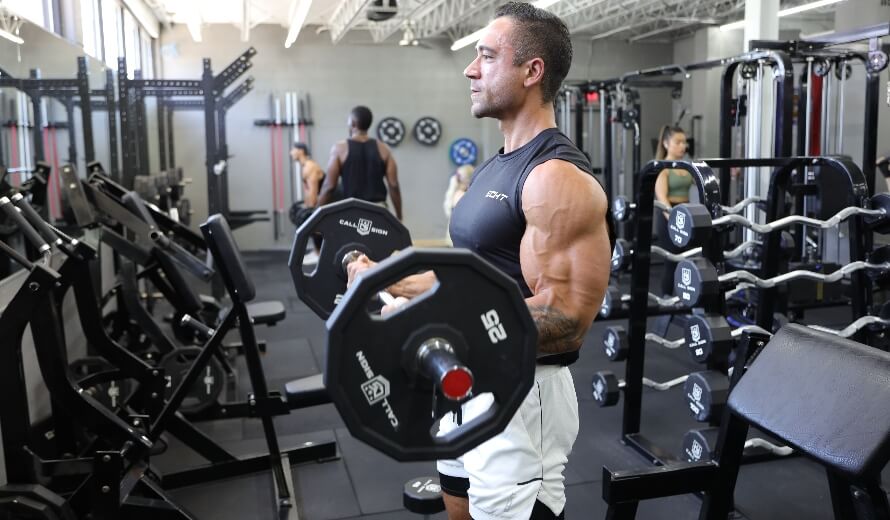
Provided you can squat, deadlift, bench press, and overhead press, these exercises should be part of the PHUL program. If, however, you want to substitute the other exercises, here are some good options:
- Incline Dumbbell Bench Press: Incline barbell bench press, flat dumbbell bench press, close-grip bench press, dip, or machine chest press
- Barbell Bent-Over Row: One-arm dumbbell row, Meadows row, chest-supported row, seated cable row, or machine row
- Lat Pulldown: Pull-up, chin-up, neutral-grip pull-up, or neutral-grip lat pulldown
- Skullcrusher: Overhead triceps extension, triceps pushdown, JM press, or cable triceps kickback
- Barbell Curl: Dumbbell curl, preacher curl, Bayesian cable curl or incline dumbbell curl
- Leg Press: Hack squat or pendulum squat
- Seated Leg Curl: Lying leg curl or Nordic leg curl
- Seated Calf Raise: Standing calf raise or leg press calf raise
- Incline Barbell Bench Press: Incline dumbbell bench press, flat dumbbell bench press, close-grip bench press, dip, or machine chest press
- Flat Dumbbell Fly: Cable fly or machine fly
- Seated Cable Row: One-arm dumbbell row, Meadows row, chest-supported row, or machine row
- Dumbbell Row: Meadows row, chest-supported row, or machine row
- Dumbbell Side Lateral Raise: Upright row or machine side lateral raise
- Incline Dumbbell Curl: Dumbbell curl, preacher curl, Bayesian cable curl or barbell curl
- Triceps Pushdown: Overhead triceps extension, skullcrusher, JM press, or cable triceps kickback
- Front Squat: Hack squat, leg press, or Bulgarian split squat
- Lunge: Bulgarian split squat, step-up, or reverse lunge
- Leg Extension: Sissy squat
- Lying Leg Curl: Seated leg curl or Nordic leg curl
- Leg Press Calf Raise: Seated or standing calf raise
Supplements to Maximize Your Results on the PHUL Workout Routine
If you follow the PHUL workout split, consider these three supplements to maximize growth, train hard, and recover faster:
- Protein powder: Protein powder, such as Whey+ (Legion’s whey isolate) or Casein+ (Legion’s micellar casein), provides your body with the nutrients needed to build muscle tissue and recover from your PHUL workouts.
- Creatine: Creatine boosts muscle and strength gain, improves anaerobic endurance, and reduces muscle damage and soreness from your workouts. For a natural source of creatine, try Legion’s creatine monohydrate, creatine gummies, or post-workout Recharge.
- Pre-workout: A high-quality pre-workout enhances energy, mood, and focus, increases strength and endurance, and reduces fatigue. For a top-tier pre-workout containing clinically effective doses of 6 science-backed ingredients, try Legion’s Pulse with caffeine or without.
(If you’d like even more specific advice about which supplements you should take to reach your health and fitness goals, take the Legion Supplement Finder Quiz, and in less than a minute, you’ll know exactly what supplements are right for you.)
Pros and Cons of the PHUL Workout Routine
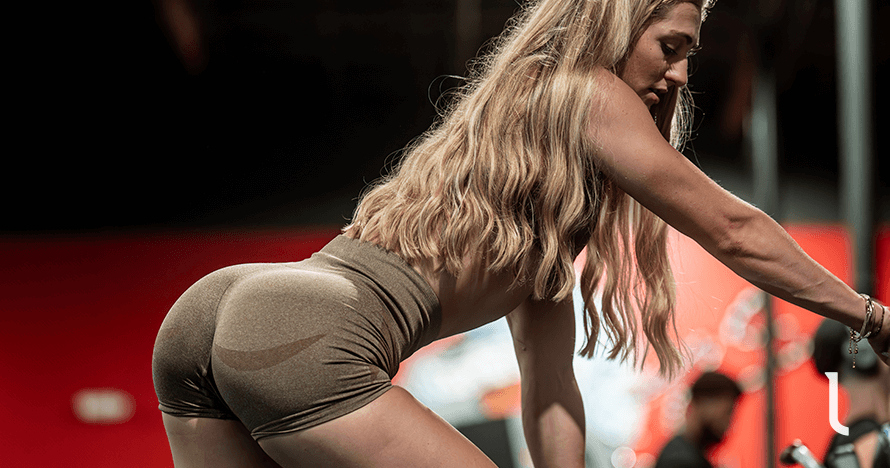
Pros
The main advantages of the PHUL workout routine are:
- Balance: You train every major muscle group twice per week, which ensures you don’t neglect any part of your body and helps you build a well-rounded, aesthetic physique.
- Variety: Each week includes both power and hypertrophy workouts, giving you a mix of heavy strength training and high-rep muscle-building work, which may boost your results more than less varied training.
- Frequency: Training each muscle group twice a week is more effective for gaining muscle and strength than training once per week.
- Simple: The PHUL program has a simple structure, which makes it more enjoyable and easier to stick with long term.
- High-Quality Training: Because PHUL spreads volume across multiple sessions, you avoid exhausting any one muscle group in a single workout. And that boosts recovery and helps you perform better in subsequent workouts.
Cons
The PHUL workout isn’t without downsides. Here are the main drawbacks:
- Long Workouts: Each session includes multiple compound and isolation exercises, which can make workouts time-consuming—especially on hypertrophy days.
- Intensity: The PHUL workout is perfect for people who like to push their limits, but it’s overkill for many.
- Not Beginner-Friendly: PHUL includes more volume than beginners need to make progress. It also involves a lot of heavy, free-weight training, which may be overwhelming for some new weightlifters.
3- and 5-Day PHUL Workout Splits
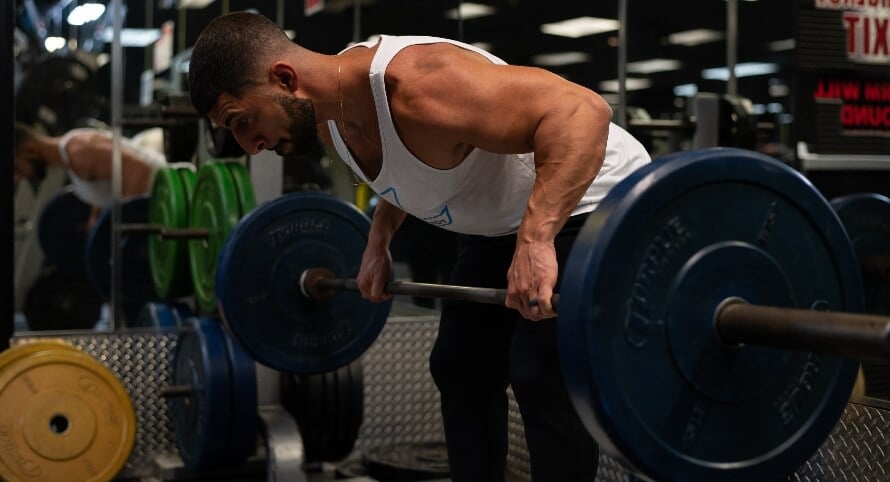
If you can’t commit to four workouts per week—or want to train a bit more—these 3- and 5-day PHUL variations let you scale the program up or down without sacrificing its core principles.
3-day PHUL Workout Routine
To run PHUL on a 3-day schedule, keep the same workout order but spread the four sessions over two weeks. You’ll train three days per week, alternating through the original 4-day split:
Week 1
- Day 1: Upper-Body Power
- Day 2: Rest
- Day 3: Lower-Body Power
- Day 4: Rest
- Day 5: Upper-Body Hypertrophy
- Day 6: Rest
- Day 7: Rest
Week 2
- Day 1: Lower-Body Hypertrophy
- Day 2: Rest
- Day 3: Upper-Body Power
- Day 4: Rest
- Day 5: Lower-Body Power
- Day 6: Rest
- Day 7: Rest
Continue cycling through the workouts in this pattern for as long as you run the program.
5-Day PHUL Workout Routine
The 5-day PHUL split separates your upper-body hypertrophy work into push and pull days, effectively turning the program into a ULPPL split. This helps keep each session shorter and ensures you train every upper-body muscle thoroughly.
Because you’re training more often and doing more total work each week, this version is only suitable if you’re an experienced weightlifter who’s bulking. For most others, it’s likely too much to recover from.
Workout 1: Upper Power
- Barbell Bench Press: 3-to-4 sets | 3-to-5 reps | 3-to-5 min rest
- Incline Dumbbell Bench Press: 3-to-4 sets | 6-to-10 reps | 2-to-3 min rest
- Barbell Bent-Over Row: 3-to-4 sets | 3-to-5 reps | 3-to-5 min rest
- Lat Pulldown: 3-to-4 sets | 6-to-10 reps | 2-to-3 min rest
- Overhead Press: 2-to-3 sets | 6-to-10 reps | 2-to-3 min rest
- Skullcrusher: 2-to-3 sets | 6-to-10 reps | 2-to-3 min rest
- Barbell Curl: 2-to-3 sets | 6-to-10 reps | 2-to-3 min rest
Workout 2: Lower Power
- Barbell Back Squat: 3-to-4 sets | 3-to-5 reps | 3-to-5 min rest
- Barbell Deadlift: 3-to-4 sets | 3-to-5 reps | 3-to-5 min rest
- Leg Press: 3-to-5 sets | 10-to-15 reps | 2-to-3 min rest
- Seated Leg Curl: 3-to-4 sets | 6-to-10 reps | 2-to-3 min rest
- Seated Calf Raise: 4 sets | 6-to-10 reps | 2-to-3 min rest
Workout 3: Push Hypertrophy
- Incline Barbell Bench Press: 3-to-4 sets | 8-to-12 reps | 2-to-3 min rest
- Flat Dumbbell Fly: 3-to-4 sets | 8-to-12 reps | 2-to-3 min rest
- Arnold Press: 3-to-4 sets | 8-to-12 reps | 2-to-3 min rest
- Dumbbell Side Lateral Raise: 3-to-4 sets | 8-to-12 reps | 2-to-3 min rest
- Dumbbell Rear Lateral Raise: 3-to-4 sets | 8-to-12 reps | 2-to-3 min rest
- Triceps Pushdown: 3-to-4 sets | 8-to-12 reps | 2-to-3 min rest
Workout 4: Pull Hypertrophy
- Pull-up: 3-to-4 sets | 8-to-12 reps | 2-to-3 min rest
- Seated Cable Row: 3-to-4 sets | 8-to-12 reps | 2-to-3 min rest
- Lat Pulldown: 3-to-4 sets | 8-to-12 reps | 2-to-3 min rest
- Dumbbell Row: 3-to-4 sets | 8-to-12 reps | 2-to-3 min rest
- Preacher Curl: 3-to-4 sets | 8-to-12 reps | 2-to-3 min rest
- Incline Dumbbell Curl: 3-to-4 sets | 8-to-12 reps | 2-to-3 min rest
Workout 5: Lower Hypertrophy
- Front Squat: 3-to-4 sets | 8-to-12 reps | 2-to-3 min rest
- Lunge: 3-to-4 sets | 8-to-12 reps | 2-to-3 min rest
- Leg Extension: 3-to-4 sets | 10-to-15 reps | 2-to-3 min rest
- Lying Leg Curl: 3-to-4 sets | 10-to-15 reps | 2-to-3 min rest
- Dumbbell Side Lateral Raise: 3-to-4 sets | 8-to-12 reps | 2-to-3 min rest
- Seated Calf Raise: 3-to-4 sets | 8-to-12 reps | 2-to-3 min rest
- Leg Press Calf Raise: 3-to-4 sets | 8-to-12 reps | 2-to-3 min rest
FAQ #1: Is the PHUL workout good?
Yes—PHUL is a solid routine for intermediate or advanced weightlifters who want to build both strength and muscle. That said, the workouts can run long and the volume is high, which makes it tough to stick with if you struggle to find time to train or your recovery isn’t dialed in.
FAQ #2: What’s the difference between PHAT and PHUL?
PHUL (power hypertrophy upper lower) is a 4-day split that combines both strength and hypertrophy training. Similarly, PHAT (power hypertrophy adaptive training) separates workouts based on their goal (strength or hypertrophy) but runs over 5 days each week and places greater emphasis on hypertrophy.
FAQ #3: Is the PHUL workout for beginners?
No—PHUL is better suited for intermediate and advanced weightlifters. Beginners will get better results from simpler routines that involve less volume, like Bigger Leaner Stronger or Thinner Leaner Stronger.
Scientific References +
- “Comparison of 1 Day and 3 Days per Week of Equal-Volume… : The Journal of Strength & Conditioning Research.” LWW, 2019, journals.lww.com/nsca-jscr/Abstract/2000/08000/Comparison_of_1_Day_and_3_Days_Per_Week_of.6.aspx.
- Crewther, Blair, et al. “The Effects of Two Equal-Volume Training Protocols upon Strength, Body Composition and Salivary Hormones in Male Rugby Union Players.” Biology of Sport, vol. 33, no. 2, 6 Mar. 2016, pp. 111–116, www.ncbi.nlm.nih.gov/pmc/articles/PMC4885621/, https://doi.org/10.5604/20831862.1196511.
- Paz, G.A., et al. “Muscle Activation and Volume Load Performance of Paired Resistance Training Bouts with Differing Inter-Session Recovery Periods.” Science & Sports, vol. 36, no. 2, Apr. 2021, pp. 152–159, https://doi.org/10.1016/j.scispo.2020.02.011. Accessed 19 May 2021.
- Stokes, Tanner, et al. “Recent Perspectives Regarding the Role of Dietary Protein for the Promotion of Muscle Hypertrophy with Resistance Exercise Training.” Nutrients, vol. 10, no. 2, 7 Feb. 2018, p. 180, www.mdpi.com/2072-6643/10/2/180/pdf.
- Eckerson, Joan M., et al. “Effect of Creatine Phosphate Supplementation on Anaerobic Working Capacity and Body Weight after Two and Six Days of Loading in Men and Women.” The Journal of Strength and Conditioning Research, vol. 19, no. 4, 2005, p. 756, https://doi.org/10.1519/r-16924.1.
- Bassit, Reinaldo Abunasser, et al. “Effect of Short-Term Creatine Supplementation on Markers of Skeletal Muscle Damage after Strenuous Contractile Activity.” European Journal of Applied Physiology, vol. 108, no. 5, 3 Dec. 2009, pp. 945–955, https://doi.org/10.1007/s00421-009-1305-1.
